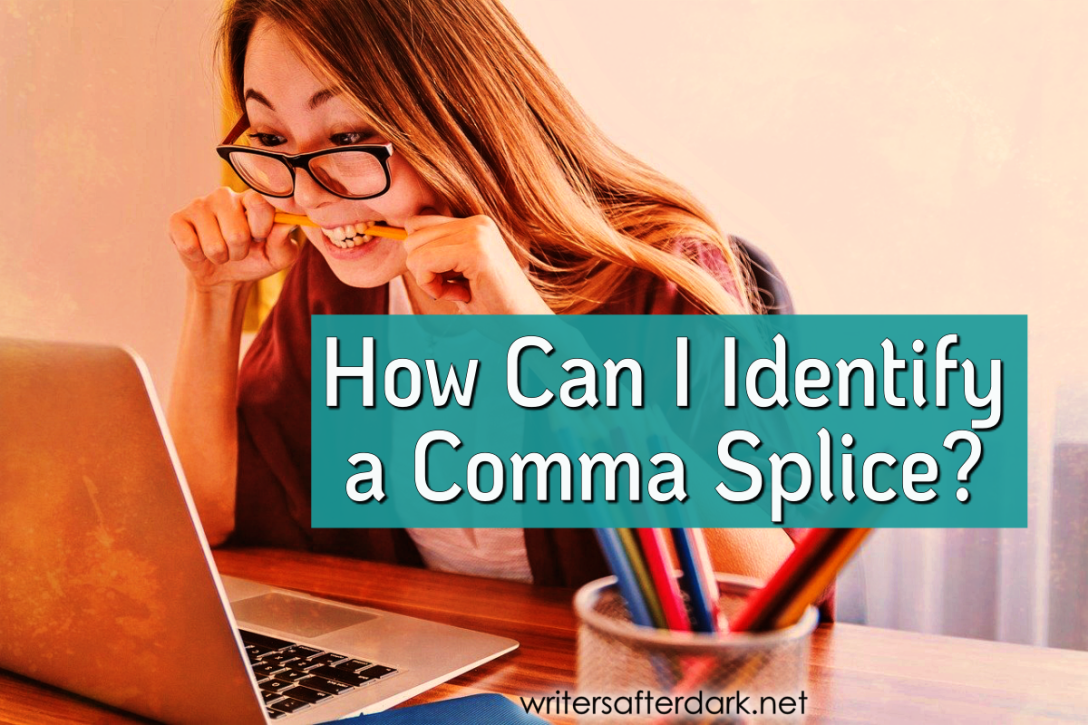Ask the Editor Series, Q7
 Q: How can I identify a comma splice?
Q: How can I identify a comma splice?
A1: Is there a comma in the sentence? Then it’s possible.
A2: This answer is complicated and completely easy at the same time, which makes it complicated to explain. And easy to explain. But allow me to try . . .
These days, comma splices are so common that they aren’t too hard to spot, even for an amateur. They’re the bane of every English teacher and easy fodder for internet trolls, while at the same time being invisible to those who write them, as this writer addresses:
Dear Lynda, My most frequent grammatical error when writing is the comma splice. For some reason, they just continuously appear in my work. Is there a reason behind it and is there a simple rule or way I can recognize and correct it before it gets to my editor?
First, let me define what, exactly, a comma splice is. The easiest definition for this type of error is the joining of two independent clauses with a comma. To go back to basics, an independent clause is a group of words (subject and verb) that can stand alone as a complete thought. A full sentence, if you will:
The dog was riding a skateboard. ✔
He was the most popular dog on the playground. ✔
Whenever you place two full sentences (independent clauses) together, if there’s a comma present, it’s usually accompanied by a conjunction:
The dog was riding a skateboard, and he was the most popular dog on the playground. ✔
A comma splice occurs when the comma is present but the conjunction is missing:
The dog was riding a skateboard, he was the most popular dog on the playground. ✘
I will be the first to admit that comma splices make me grind my teeth. They frustrate me. And in formal writing or in a nonfiction setting like a textbook, they are wrong. Very, very wrong.
But you may be surprised—full disclosure: as I was, long ago—to find that they’re not always wrong.
How can that be? Either something is wrong or it’s not, and comma splices must certainly fall on one side of the fence or the other.
But let me clarify: comma splices are always wrong grammatically. They’re just not always wrong stylistically.
Here’s the thing about comma splices: if you’re a fiction writer whose story includes a lot of dialogue, you’re bound to use commas when it’s questionable. Why is that okay? Well, it’s because that’s what reflects realistic dialogue.
When we speak, we don’t always use full sentences, and we don’t always speak with precise grammatical correctness. We speak in fragments, run-on sentences, and everything in between. Think of any child who’s excited about something that happened to them, and picture this:
“Mother, there was a dog at the playground today. He was on a skateboard, and he was very popular. Everyone thought he was terrific. He rode back and forth for hours.”
Grammatically, it’s correct. But does it sound like anyone, ever? Not anyone who’s normal, anyway. Right? People (especially children) talk more like this:
“Mom, there was this dog at the playground, he had a skateboard, and he was all over the place, everyone was cheering for him, he kept going all afternoon!”
Grammatically, it’s cringeworthy, but it’s much more realistic in terms of dialogue, and therefore a better stylistic choice.
So how do you recognize if you’re using comma splices? You can take a look at what’s on either side of the comma, first of all, and see if each portion can be a complete sentence on its own. If it can (i.e. if each portion is an independent clause), then you have a comma splice on your hands.
If the splice is in dialogue, I’d say don’t worry about it, and your editor will tell you if it’s awkward or not. If it’s in the narrative, though, try your best to separate the two independent clauses by either adding a conjunction after the comma, using a semicolon in place of the comma (yes, this is how semicolons can be used properly), separating the sentences with a period, or if all else fails, recasting the sentence so you don’t need any of the other solutions mentioned.
Happy writing! And feel free to submit your questions here so I can answer them in a future post.
If you have any questions, don’t forget to
Ask Lynda the Awesomest Editor™
All the answers . . . according to me!


I occasionally use a comma splice in a fiction narrative. I know it’s not grammatically correct, but it works for me in certain instances. I think we need to know we are breaking a “rule” before doing it, though.
LikeLiked by 2 people
I think that’s really the key to it, KT. So many people who use comma splices just don’t know any better. If you’re using one purposely in a rare instance, it should have the effect you’re aiming for, which is to cause the reader to pay attention to the flow of that sentence in a different way. Knowing the rules is the key to breaking them well, I think.
LikeLiked by 1 person
I found the perfect solution to my comma splice love; I have you edit my work. 🙂 It is my 2020 goal to master comma usage!
LikeLiked by 1 person
I (sometimes) love your comma splices, Raymond, because that usually means I’m reading a manuscript that’s scaring the bejeebies out of me. I’ll never forget editing The Devil’s Hour, crammed into a corner with my feet tucked up off the floor, all the lights on in the entire house . . . the comma splices were the least of my fears.
That said, I won’t say no to your 2020 goal. 😀
LikeLike
Best definition and examples I’ve come across! Thank you, Lynda. 🙂
LikeLiked by 1 person
Thank you! One can never go wrong with a dog on a skateboard, right?
LikeLiked by 1 person
😀 😀 😀
LikeLike
[…] via How Can I Identify a Comma Splice? — Writers After Dark […]
LikeLiked by 1 person
The dreaded comma splice! It’s amazing how I can spot one immediately in anything I’m reading, but when I’m writing… Well.
LikeLiked by 1 person
I’m great at spotting other people’s mistakes (written or otherwise—it’s a gift) but am always surprised when others point out my own.
LikeLiked by 1 person
It’s very rude of them. How dare they?
LikeLiked by 1 person
I try my best to refrain from pointing out that I am practically incapable of making those kinds of mistakes. It’s tough, but I’m above that sort of behavior, of course.
LikeLike